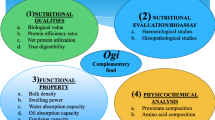Abstract
Cereal grains, legumes and pulses comprise the largest proportion in a typical South-Asian diet plate. This research is mainly focusing on determining the macronutrient composition of major cereals, legumes and pulses commonly consumed in local Sri Lankan cuisine, in their cooked form. White samba, White Basmati, Red Kekulu and Nadu rice were selected as the main rice varieties and in addition maize, and wheat, finger millet flour-based foods too were analyzed. Red cowpea, green gram, chickpea and soya bean based foods were analyzed for macronutrient compositions as they are more frequently consumed by the local population, while the most preferred curry item; ‘lentils’, was analyzed along with soya curry; another preferred item by millions of locals. Wheat flour based items like bread were taken into analysis since, they have become the second most preferred food next to rice. Every item was cooked according to the common culinary practices in aim to determine the “realistic nutrient gain”. Proximate analysis was carried out according to the AOAC standard guidelines for the determination of moisture, carbohydrate, fat, and protein whereas, insoluble dietary fiber and soluble dietary fiber were determined using enzymatic digestion in vitro models. Results revealed digestible carbohydrate level range from 64.6 ± 5.3 to 74.6 ± 7.2% among tested rice varieties, while protein content varies from 5.6 ± 2.2 to 8.9 ± 2.6. Insoluble dietary fiber was high in boiled raw rice (9.8 ± 0.2) and low in boiled White Basmati. Amongst tested leguminous beans, pressure cooked red cowpea elicited the highest protein level (24.5 ± 2.3%), while pressure cooked green gram had the lowest protein content (20.0 ± 0.6%). Pressure cooked chick pea was having higher insoluble dietary content (14.8 ± 1.3%) compared to other beans. Soybean curry elicited the highest protein (36.6%) and fat content (8.2%) among all the tested varieties. Pittu (puttu) and roti varieties made with wheat flour and finger millet flour resulted considerably higher levels of digestible fiber compared to roti made with whole wheat flour. It can be concluded that typical Sri Lankan diets are rich in fibre and protein, while they provide excellent macronutrient profiles due to the proper complementary mixing of food ingredients.
Similar content being viewed by others
References
Abeysekera WKSM, Arachchige SPG, Ratnasooriya WD, Chandrasekharan NV, Bentota AP (2017) Physicochemical and nutritional properties of twenty three traditional rice (Oryza sativa L.) varieties of Sri Lanka. J Coast Life Med 5:343–349
AOAC Method 922.06, Method 993.19 and Method 993.21 (1984) 15th edn, Washington, DC
Asp NG, Johansson CG, Hallmer H, Siljestrom M (1983) Rapid enzymatic assay of soluble and insoluble dietary fibre. J Agric Food Chem 31:476–482
Croon LB, Guchs G (1980) Crude fat analysis of different flours and flour products. VarFoda 32:425–427
Darandakumbura HDK, Wijesinghe DGNG, Prasantha BDR (2013) Effect of processing conditions and cooking methods on resistant starch, dietary fiber and glycemic index of rice. Trop Agric Res 24(2):163–174
Ekanayake S (2010) Take a GI check on Lankan food. Sunday Times. http://www.sundaytimes.lk/100919/MediScene/mediscene_1.html. Accessed 12 Feb 2018
Herath RM, Warnakulasuriya HU, Thilakarathna KG, Gunawardena JAT (2007) Analysis of food consumption patterns in Sri Lanka with special reference to energy intake by Department of Agriculture—AFACI Publication Library. Ann Sri Lanka Dep Agric 9:51–58
Hettiarachchi P, Jiffry MTM, Jansz ER, Wickramasinghe AR, Fernando DJS (2001) Glycaemic indices of different varieties of rice grown in Sri Lanka. Ceylon Med J 46(1):11–14
Hettiaratchi UPK, Ekanayake S, Welihinda J (2009) Glycaemic indices of three Sri Lankan wheat bread varieties and a bread-lentil meal. Int J Food Sci Nutr 60:21–30
Holm J, Bjorck I, Drews A, Asp NG (1986) A rapid method for the analysis of starch. Staerke 38:224
Jayasinghe KWMA, Ranaweera KKDS (2015) Nutrition assessment of several sects in the Sri Lankan community. Population 140(42):58
Katulanda P, Sheriff MHR, Matthews DR (2006) The diabetes epidemic in Sri Lanka—a growing problem. Ceylon Med J 51:26–28
Messina MJ (1999) Legumes and soybeans: overview of their nutritional profiles and health effects. Am J Clin Nutr 70(3):439s–450s
Pathiraje PMHD, Madhujith WMT, Chandrasekara A, Nissanka SP (2010) The effect of vice Variety and parboiling on in vivo glycemic response. Trop Agric Res 22:26–33
Rajapakse R, Sandanayake CA, Pathinayake B (2000) Foot prints in rice variety improvement and its impact on rice production in Sri Lanka. In: Annual symposium of the Department of Agriculture, Department of Agriculture, Sri Lanka, pp 423–433
Ranawake AL, Amarasingha UGS, Dahanayake N (2013) Agronomic characters of some traditional rice (Oryza sativa L.). Cultiv Sri Lanka 1:3–9
Report FAO (1993) Rice in human nutrition. Food and Agriculture Organization of the United Nations, Rome
Senadheera SPAS (2016) Nutritional evaluation and influence on carbohydrate and lipid metabolism of porridge made with green leafy vegetables. Library digital repository. University of Sri Jayewardenepura. Sri Lanka. http://dr.lib.sjp.ac.lk/handle/123456789/3324. Accessed 20 June 2018
Slavin J (2003) Why whole grains are protective: biological mechanisms. Proc Nutr Soc 62(1):129–134. https://doi.org/10.1079/PNS2002221
Sri Lanka Pulses consumption-1992–2007 (2011) World data atlas. https://knoema.com/atlas/Sri-Lanka/topics/Food-Security/Food-Consumption/Pulses-consumption. Accessed 12 Feb 2018
Author information
Authors and Affiliations
Corresponding author
Additional information
Publisher's Note
Springer Nature remains neutral with regard to jurisdictional claims in published maps and institutional affiliations.
Rights and permissions
About this article
Cite this article
Silva, V., Jayasinghe, M.A., Senadheera, S.A. et al. Determination of macronutrient compositions in selected, frequently consumed cereals, cereal based foods, legumes and pulses prepared according to common culinary methods in Sri Lanka. J Food Sci Technol 57, 816–820 (2020). https://doi.org/10.1007/s13197-019-04085-x
Revised:
Accepted:
Published:
Issue Date:
DOI: https://doi.org/10.1007/s13197-019-04085-x




